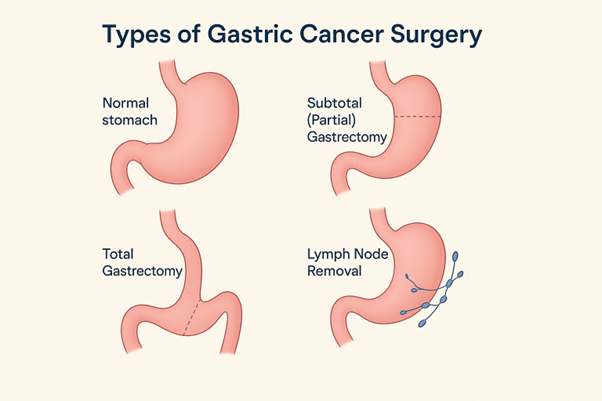Gastric (stomach) cancer surgery
Expert care, compassionate support, better outcomes.
Being diagnosed with stomach cancer (also known as gastric cancer) can feel incredibly overwhelming. At Auckland Laparoscopic Surgery, we understand the worry, uncertainty, and emotional weight that often comes with this news.
Our experienced team is here to support you with warmth and clarity from the very beginning. We’ll guide you through each step with a personalised treatment plan tailored to your specific needs, backed by the latest surgical expertise and a genuine commitment to your wellbeing.
You’re not facing this alone. We’re with you, every step of the way.
What is gastric (stomach) cancer?
Gastric cancer develops when abnormal cells begin to grow in the lining of the stomach. Over time, these cells can form a tumour and, in some cases, may spread to nearby lymph nodes, the liver, or surrounding organs. The most common form is called adenocarcinoma, which begins in the cells that line the inside of the stomach.
In the early stages, gastric cancer may not cause any noticeable symptoms. As it progresses, however, some people may begin to experience:
- Persistent indigestion or heartburn
- Feeling full after small meals
- Unintentional weight loss
- Nausea or vomiting
- Fatigue or weakness
- Blood in vomit or stool
If you’ve noticed any of these symptoms, especially if you have risk factors such as a family history of stomach cancer or a past infection with Helicobacter pylori, it’s important to speak with your doctor. Early assessment can make a real difference in diagnosis and treatment outcomes.
How is stomach cancer diagnosed?
If your doctor suspects stomach cancer, there are several tests that can help confirm a diagnosis and guide the next steps in your care. These may include:
- Gastroscopy (endoscopy) – to look inside the stomach and take biopsies.
- CT scans or PET scans – to check for spread to other parts of the body.
- Blood tests – to assess your overall health.
Once all the results are in, your surgical team will carefully review them to determine the stage of the cancer and whether surgery is the most appropriate treatment option for you. We’ll take the time to explain everything clearly, and support you in making informed decisions at each step.
Surgical treatment for gastric cancer
Types of gastric cancer surgery
- Normal stomach anatomy
- Subtotal gastrectomy – removal of lower portion
- Total gastrectomy – complete removal and reconstruction
- Lymph node removal

1. Subtotal (partial) gastrectomy
This involves removing part of the stomach, usually when the cancer is located in the lower portion. The remaining section of the stomach is then carefully reconnected to the small intestine so digestion can continue.
2. Total gastrectomy
For more extensive cancers, the entire stomach may need to be removed. In this case, the oesophagus (food pipe) is joined directly to the small intestine.
In both types of surgery, nearby lymph nodes are also removed, as these are areas where stomach cancer can sometimes spread.
Whenever possible, we perform these procedures using minimally invasive laparoscopic (keyhole) techniques, which involve smaller incisions, less discomfort, a faster recovery, and a lower risk of complications.
You’ll be supported by a skilled and compassionate team throughout your treatment and recovery.
Benefits of gastric cancer surgery
- Potential to completely remove cancer
- Essential part of any treatment package to provide opportunity for cure
- Symptom relief (nausea, bleeding, obstruction)
- Usually combined with chemotherapy or other targeted therapies
Risks and considerations
- Bleeding or infection
- Leakage from surgical joins
- Nutritional challenges after surgery (especially with total gastrectomy)
- Weight loss and digestive changes
- Recovery time and possible need for adjuvant treatment (chemo or radiation)
Our team will work closely with you before and after surgery, including access to dietitians and oncology support, to ensure the best outcomes and quality of life.
Recovery and life after surgery
Recovery will depend on the type of surgery and your general health. Most patients stay in hospital for 4–6 days and return to light activity within a few weeks.
After surgery, you may need to:
- Eat smaller, more frequent meals
- Take vitamin supplements (especially multivitamins and B12)
- Attend regular follow-up appointments and scans
- Work with a dietitian to manage nutritional changes
You won’t be alone. Our multidisciplinary care team is here to support your recovery every step of the way.
For many people with early or locally advanced stomach cancer, surgery offers the best chance of effective treatment. The aim is to remove the tumour and any affected nearby tissue, while preserving as much healthy stomach function as possible.
At Auckland Laparoscopic Surgery, we tailor each surgical approach to your individual needs, using the latest techniques to support a smoother recovery and better outcomes.
Types of gastric cancer surgery we perform include:
Why choose Auckland Laparoscopic Surgery?
When you’re facing a diagnosis like stomach cancer, choosing the right team can make all the difference, not just in your treatment, but in how supported and confident you feel along the way. At Auckland Laparoscopic Surgery, we combine advanced surgical expertise with a deeply compassionate, patient-first approach. From your initial consultation to life beyond surgery, we’re here to guide, support, and care for you at every stage.
- Highly experienced upper GI surgeons
- Minimally invasive techniques for faster healing
- Individualised cancer care plans
- Supportive, patient-centred approach
- Collaborative care with your oncologist and GP
We are committed to not only treating cancer, but helping you live well after surgery.
Take the next step
If you or a loved one has been diagnosed with stomach cancer, we’re here to help. Early consultation gives you the best treatment options and outcomes. Contact Auckland Laparoscopic Surgery to book an appointment with one of our upper gastrointestinal specialists. Based in Auckland, we proudly care for patients across New Zealand.

